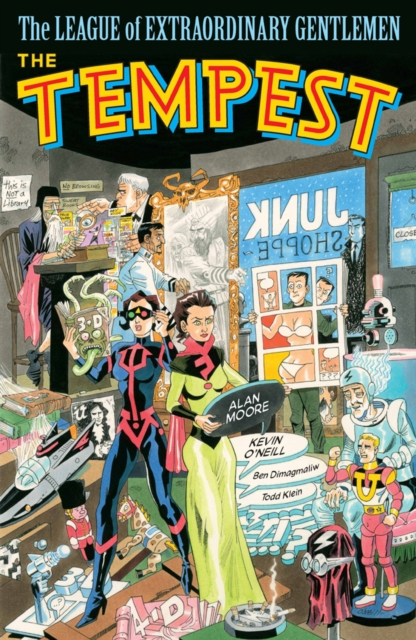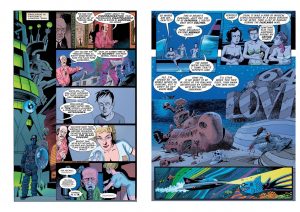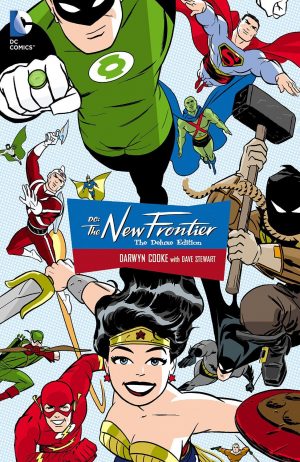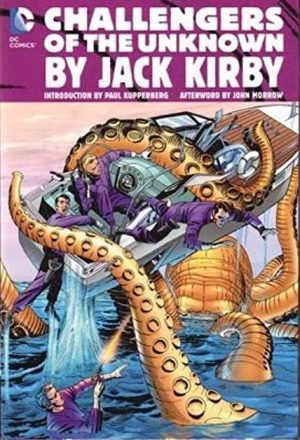Review by Graham Johnstone
Most readers picking up this final volume of Moore and O’Neill’s The League of Extraordinary Gentlemen will know this is an integrated fictional universe enabling the ultimate crossover story.
The Tempest opens right after Century 2009, with League survivors Mina (Dracula) Murray, and transexual warrior, Orlando joined by defecting spy boss Emma Night. They are pursued by her successor as ‘M’, and aided by the latest generation of the Nemo cast, so also concluding that spinoff strand. Moore endeavours to make each book satisfy on its own, and is adept at weaving backstory into dialogue and developing events. However, the sheer intricacy of plot, settings, characters and ideas woven through the preceding thousand pages, make it well worth (re)reading from the start.
Moore further extends his literary plunderings to ephemeral British superheroes, and ‘the Bard’, specifically the play that offers this volume’s title. What these sources have in common is favouring the marvellous over the mundane. Moore famously dragged the fantastic into realism with his superhero deconstruction Watchmen, and here stages the most epic reversal. Shakespeare’s The Tempest had the sorcerer Prospero contemplating his life and impending finale. Thought the last play he wrote alone, it reads as a swan-song for the playwright, as this book does for Moore and O’Neill, who both reached pension age completing this final work in comics. Moore always builds on his fictional sources, swapping Prospero’s island for alternative dimension The Blazing World, and expanding that book’s invasion of the everyday world, to the sorcerous unleashing of all the realms of the fantastic.
Initial publication was a pamphlet series presented as British-style anthology comics: from ‘Illustrated Masterpieces’, through girls’ weekly ‘Mina’, to ‘2010 AD’ (sic). Artist Kevin O’Neill’s ability should be no surprise, but his range might be. He brilliantly pastiches everything from newspaper adventure strips, to Beano-style cartoons, to painted covers. It’s collected here, complete with original covers, editorials on British comics, and spoof letters, notably “Margaret Atwood, Gilead-on-the-Yukon” bemoaning the 30th Century heroines having “figure-hugging costumes and stripper-type names, [but] I suppose it could be worse.” A welcome addition is an afterword with Moore and O’Neill reflecting informatively on their series’ aspirations and reception.
So, impressive in principle, how is it in practice? Moore assembles a diverse and appealing cast, and continues to build ingeniously on earlier stories, notably in the escalating hostilities between Emma and agent ‘Jimmy’. This strand best provides the ‘rousing adventure’ promised on earlier volumes, and triggers the momentous events predicted in Century 1910, providing the most epic plot imaginable. This backdrop adds tension to the Nemo strand’s sideshow of magical refugees, and travelogue of the far reaches of this composite earth. 3D art (glasses supplied) and Shakespearian verse interludes make this a dazzling, yet demanding, read. A third strand set in the 30th Century, assembles forgotten British superheroes as ‘Seven Stars’. They can’t match the appeal of classic characters developed over several volumes. What entertained as a back-up feature in the pamphlets, now feels an interruption to a graphic novel already requiring sustained concentration. Readers may be tempted to skip this, but it feeds into the main narrative, as the Stars time-travel back to save their reality from Prospero’s apocalypse. The ending is so epic and climactic, that even emancipated divorcee Mina is less a protagonist than a fellow spectator of the unfolding catastrophe.
The Tempest is best read after the other volumes, and lingeringly, enjoying each delightful page without agonising over all the references and plot intricacies. It’s a fitting end to perhaps the most ambitious comics series ever.







